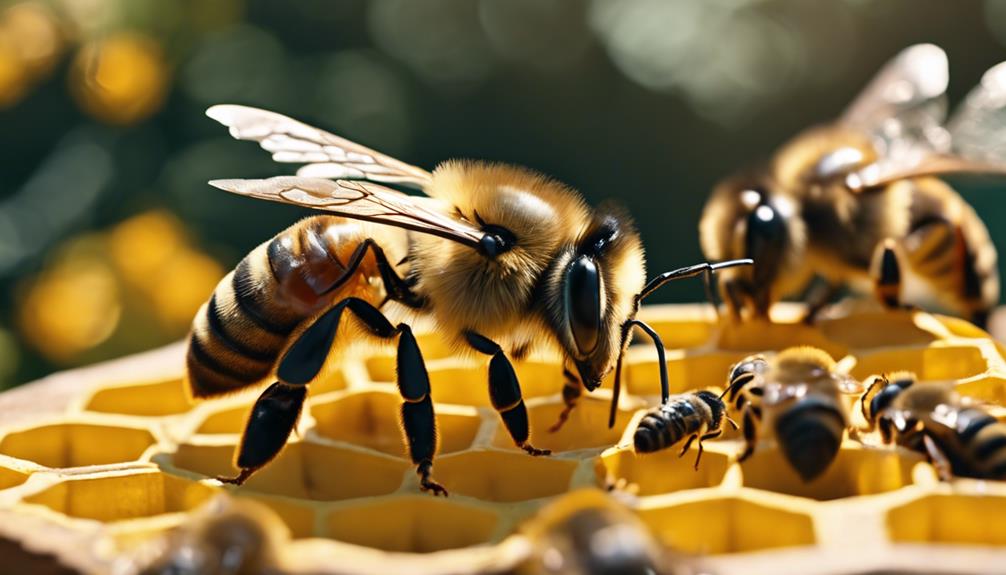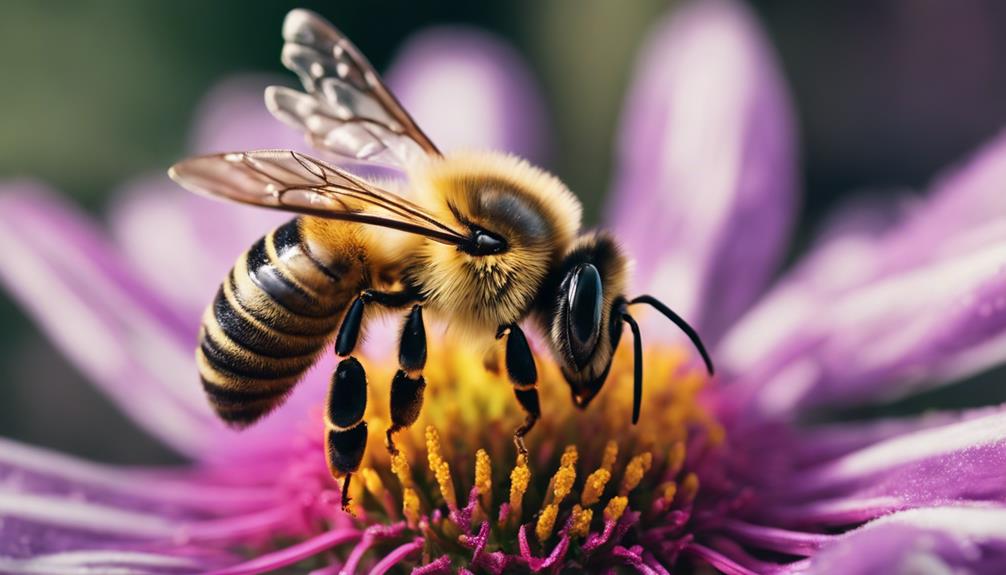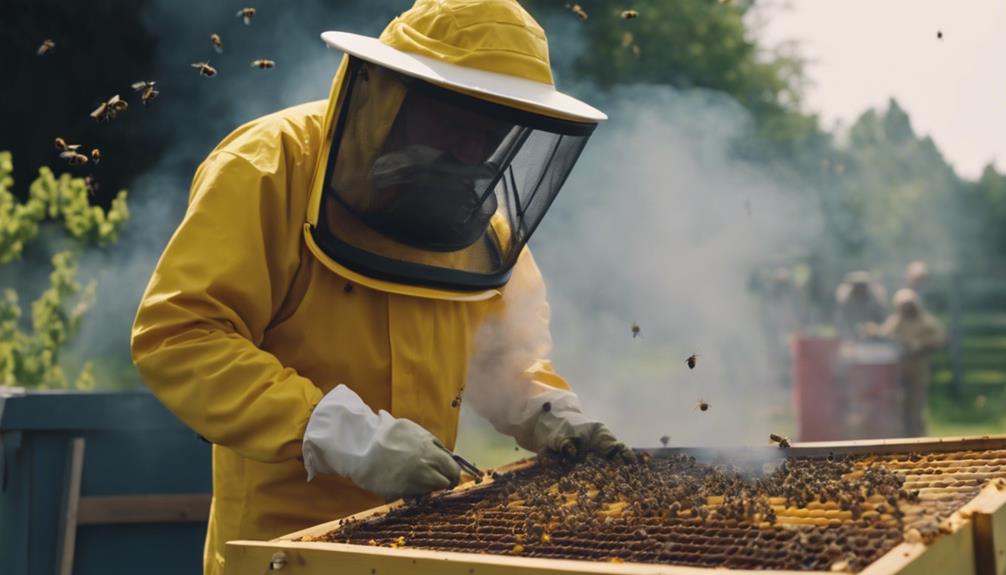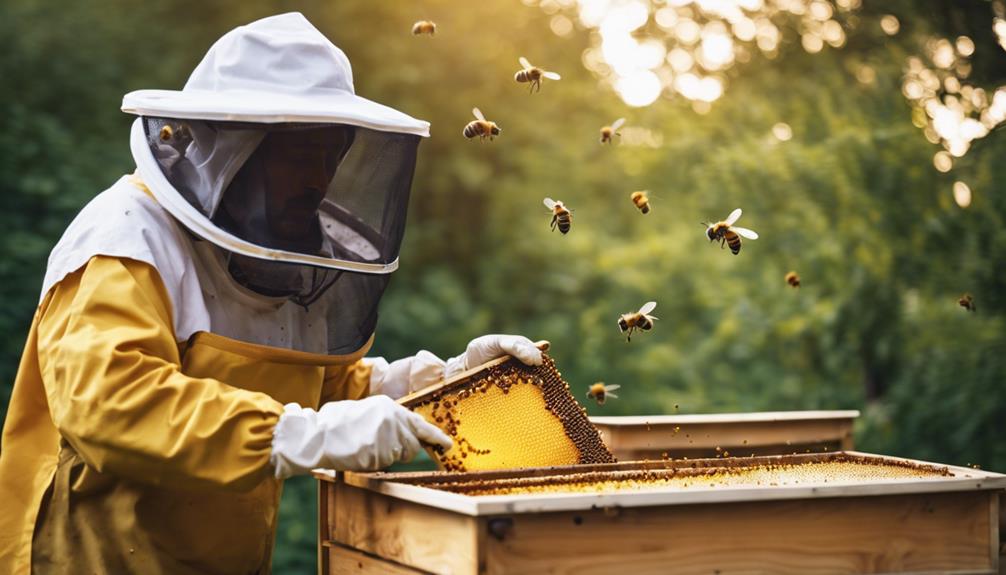Worker bees, the powerhouse of the hive, are fueled by royal jelly as larvae and zip through a busy life cycle in about 21 days, living a month in summer or up to 8 months in winter. These gals are not slackers; they maintain the nest meticulously, from regulating temperature by fanning wings to hoarding nectar and pollen in their teeny pollen baskets. Ever heard of a bee dance party? Nope, neither have we, but worker bees sure know how to communicate, cooperating flawlessly to sustain the hive. Curious to uncover more about these diligent bees’ secrets?
Main Points
- Worker bees have specific anatomical traits for their roles.
- They are genetically female and infertile, focusing on hive tasks.
- Worker bees adapt lifespans based on seasonal needs.
- They maintain hive temperature, cleanliness, and defense.
- Worker bees demonstrate unity, cooperation, and selflessness for hive sustainability.
Life Cycle Overview
During their life cycle, worker bees undergo a series of stages that are essential to the functioning of the hive. From the moment we hatch as larvae, we’re nurtured with royal jelly, a special mix of pollen, and honey. This diet sets us on the path to becoming diligent worker bees.
Our development from egg to adult typically takes about 21 days, during which we progress through various tasks like hive maintenance and resource management. As worker bees, we’ve a crucial role in ensuring the smooth operation of the colony.
Our lifespan may vary depending on the season, lasting around one month in summer but extending to 6-8 months in winter. Through our dedicated efforts, we contribute to the overall success and sustainability of the hive.
Nest Maintenance Duties
As worker bees, one of our primary responsibilities is maintaining the nest through tasks such as cleaning and repairing brood cells to uphold a hygienic environment for the colony. Here are some key nest maintenance duties we diligently perform:
- Regulating Hive Temperature: We use our incredible ability to fan our wings or cluster together to keep the nest at just the right heat, ensuring the comfort and survival of the colony.
- Building Honeycomb Structure: We construct and expand the intricate honeycomb, providing ample storage space for pollen, nectar, and eggs, essential for the well-being of the hive.
- Sealing Cells for Insulation: Using beeswax and propolis, we seal mature honey cells tightly, safeguarding the stored food and maintaining nest insulation for protection against external elements.
Food Collection Responsibilities

Worker bees actively engage in the collection of nectar and pollen from flowers to support the hive’s crucial needs. Using our proboscis, we extract nectar, storing it in our honey stomach for transport.
Additionally, we gather pollen on our hind legs in pollen baskets, ensuring we bring back a good supply of provisions for the colony. This food gathering process is essential for the sustenance of the hive, as nectar and pollen serve as the building blocks for creating honey and feeding our fellow bees.
Through our foraging efforts, we contribute significantly to the overall well-being of the hive, ensuring that there’s always enough food to support the queen, larvae, and other members of our community.
Hive Temperature Regulation
Maintaining ideal hive temperature is a vital task for worker bees, guaranteeing the colony’s survival in varying weather conditions. Here’s how they do it:
- Fanning Wings: Worker bees regulate hive temperature by collectively fanning their wings to cool the hive during hot weather.
- Generating Heat: To combat colder temperatures, worker bees generate heat by vibrating their flight muscles, maintaining warmth for brood development and honey preservation.
- Adjusting Hive Temperature: Through coordinated efforts, worker bees manage the hive’s internal climate, essential for colony survival, especially in extreme weather conditions. Their ability to adjust hive temperature ensures the overall health and productivity of the colony.
Hive Defense Mechanisms

Worker bees exhibit remarkable defensive behaviors to safeguard their hive. These diligent insects take on roles as guard bees, patrolling the entrance and ensuring only authorized individuals enter.
When threats loom, they bravely sacrifice themselves by stinging intruders, showcasing their unwavering commitment to protecting their queen and colony.
Defensive Bee Behavior
When safeguarding their hive, worker bees exhibit a remarkable level of self-sacrifice and determination.
- Worker bees, with their barbed stinger, engage in sacrificial stinging to protect the hive.
- They react swiftly to threat responses, perceiving danger to guarantee colony safety.
- Being the primary defenders due to their lack of stinging ability in drones and queen bees, worker bees display defensive behavior rooted in their acute danger perception.
Worker bees truly embody the spirit of unity and courage, putting the needs of the colony above their individual safety. This sacrificial instinct highlights their unwavering commitment to safeguarding the hive, making them crucial guardians in the complex world of bee society.
Guard Bee Duties
What methods do guard bees employ to protect the hive from potential threats?
Guard bees are like the vigilant security team of the hive, always on high alert. They rely on their keen sense of smell and sharp vision to identify any looming dangers. These dedicated defenders communicate swiftly through pheromones, sending out urgent signals to alert other worker bees about incoming threats.
When faced with danger, guard bees exhibit assertive and aggressive behavior, ready to sting and protect their home at all costs. Their brave actions not only safeguard the hive but also contribute significantly to the overall safety and security of the entire bee colony.
Guard bees play a crucial role in maintaining order and defending the hive against any potential harm, ensuring the well-being of their fellow worker bees.
Honey Production Tasks
We worker bees play an essential role in honey production within the hive. Our tasks involve gathering nectar from flowers, storing it in honeycomb cells, and transforming it into delicious honey through evaporation.
Worker Bee Roles
Worker bees actively engage in various tasks essential for honey production. These include feeding bee larvae, constructing honeycomb, and safeguarding the hive. These roles are vital for the smooth functioning of the hive and the overall well-being of the colony.
Here are some key responsibilities of worker bees:
- Feeding Bee Larvae: Worker bees diligently care for the young bees, ensuring they receive the necessary nutrition for healthy growth.
- Building Honeycomb: These bees skillfully construct intricate honeycomb structures where honey is stored and larvae develop.
- Defending the Hive: Worker bees protect the hive from potential threats, ensuring the safety of the queen bee and the entire colony.
Through these roles, worker bees contribute significantly to honey production, hive health, and the sustainability of the colony.
Honey Harvesting Process
During the honey harvesting process, worker bees diligently collect nectar from flowers and transform it into honey within the hive. They undergo a fascinating process of nectar collection, where they use their proboscis to suck up the sweet liquid.
Back in the hive, the bees regurgitate the nectar into beeswax cells, kickstarting the evaporation process. As the bees fan their wings over the honeycomb cells, the nectar gradually dries and thickens into delicious honey.
Once the honey reaches the perfect consistency, worker bees meticulously seal the cells with beeswax for safe storage. This intricate dance of nectar gathering, evaporation, and honey sealing showcases the remarkable teamwork and dedication of worker bees in producing nature’s golden treasure.
Social Interaction Roles

Engaging in various forms of communication and cooperation, worker bees fulfill essential social interaction roles within the hive.
- Worker bees communicate through dance, pheromones, and physical interactions to convey information essential for the colony’s survival.
- They engage in trophallaxis, sharing food and information mouth-to-mouth, fostering colony cohesion and ensuring resource distribution.
- Additionally, worker bees perform undertaker tasks, diligently removing deceased bees and debris, maintaining hive cleanliness and preventing disease spread.
These social interactions, from communication to altruistic behavior, play an important role in sustaining the hive’s functionality and unity.
Whether through grooming each other for hygiene or sacrificing themselves for the greater good, worker bees exemplify a remarkable level of cooperation and selflessness within their community.
Seasonal Adaptations
Amid changing seasons, worker bees demonstrate remarkable adaptations to guarantee the hive’s sustainability and productivity.
In the summer, bees live for a short 5-6 weeks, focusing on essential tasks like pollination and hive maintenance. These summer bees are the backbone of the hive’s functions during warmer months.
On the other hand, winter bees have a longer lifespan, enduring for 6-8 months. They’re larger in size and play a vital role in insulating the hive and keeping the queen warm during colder periods.
Worker bees adjust their lifespans based on seasonal demands, ensuring the colony’s continuity and success.
Understanding these seasonal adaptations helps in effectively managing hive resources, ensuring the hive’s survival throughout the year.
Unique Genetic Traits

Worker bees’ distinctive genetic traits are crucial to their role in maintaining hive functionality and supporting the queen.
- Genetically Female: Worker bees are all genetically female, with specific anatomical characteristics that prevent them from reproducing, guaranteeing their focus on other tasks in the hive.
- Infertility and Altruistic Service: Their infertility, a result of kin selection, drives their selfless and altruistic service to the colony, highlighting their dedication to the greater good.
- Smooth Functioning: These worker bees dedicate their lives to various hive duties, motivated by their genetic makeup to secure the smooth functioning and survival of the colony, ultimately supporting the queen in her crucial role.

Hello! My name is Noel Calvin. I graduated from UCLA and now work as a writer at Launch Ninjas. I write blog posts that inspire and guide our readers in their entrepreneurial pursuits. I live in Pleasantville, NJ, with a peaceful yet lively atmosphere that inspires me.
Writing stories is more than just a job for me. It allows me to share my observations and satisfy my curiosity about the world. I combine my analytical skills with creative enthusiasm to delve into technology trends and startup stories. But my life isn’t limited to screens and keyboards. I value loyalty, passion, and a touch of old-fashioned charm, which I infuse into every narrative I create.
I love spending time in my garage, jamming with my band when I’m not writing. Playing the guitar and singing bring me immense joy. I also enjoy capturing ordinary and extraordinary moments through my camera lens and exploring new culinary adventures that excite my taste buds. I’m always seeking new experiences.
My family is very important to me. Joyful Sunday brunches filled with laughter and intense board game nights keep me grounded, reminding me of life’s simple pleasures.
In my world, every moment is an opportunity for discovery. Every discovery is a story worth sharing, whether a heartfelt moment at home or the pulse of technological innovations. Join me as I navigate through life, one blog post, one guitar strum, and one heartwarming family dinner at a time.


